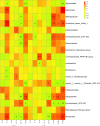Dynamic Changes in Gut Microbiome of Ulcerative Colitis: Initial Study from Animal Model
- PMID: 35494313
- PMCID: PMC9049869
- DOI: 10.2147/JIR.S358807
Dynamic Changes in Gut Microbiome of Ulcerative Colitis: Initial Study from Animal Model
Abstract
Background: An animal model of DSS-induced UC has been widely used in basic research, and the dysbiosis of gut microbiome is one of the important pathogenetic mechanisms of DSS-induced UC, but its dynamic changes and correlation with inflammatory factors are not clear yet.
Methods: Clinical signs and tissue damage degree of C57BL/6 ulcerative colitis mice model induced by different concentrations of DSS were compared with that of normal mice, and finally the optimal concentration of DSS was determined. Then we analyzed the sequencing results of gut microbiome and inflammatory factors to determine the dynamic patterns of gut microbiome and their correlation with the inflammatory factors.
Results: DSS at 2.5% and 3.0% concentration could cause intestinal injury and induce colitis. However, 3.0% DSS resulted in higher mortality. In addition, there were dynamic changes of gut microbiome in DSS-induced UC model: the relative abundance of intestinal flora increased first and then decreased in Bacteroides, Parabacteroides, Romboutsia, Clostridium_sensu_stricto_1, Lachnospiraceae_NK4A136_group, norank_f_norank_o_Clostridia_UCG-014, Parasutterella, and decreased first and then increased in Lactobacillus, Muribaculum, norank_f_Muribaculaceae, in addition, Bifidobacterium, Coriobacteriaceae_UCG-002 and Enterorhabdus did not change in the first 14 days but increased significantly on day 21. Moreover, inflammatory cytokines were closely associated with the imbalance of the intestinal microbiota in mice with UC: most pathogenic bacteria in the intestinal tract of the UC animal model were positively correlated with pro-inflammatory factors and negatively correlated with anti-inflammatory factors, while beneficial bacteria were the opposite.
Conclusion: Intestinal microecology plays an important role in DSS-induced UC model, and the relative abundance of gut microbiome changes dynamically in the occurrence and development of ulcerative colitis.
Keywords: 16S rDNA; DSS; dynamic changes; gut microbiome; ulcerative colitis.
© 2022 Gu et al.
Conflict of interest statement
The authors report no conflicts of interest in this work.
Figures







Similar articles
-
2,3,5,4'-Tetrahydroxystilbene-2-O-β-D-glucoside, a major bioactive component from Polygoni multiflori Radix (Heshouwu) suppresses DSS induced acute colitis in BALb/c mice by modulating gut microbiota.Biomed Pharmacother. 2021 May;137:111420. doi: 10.1016/j.biopha.2021.111420. Epub 2021 Feb 23. Biomed Pharmacother. 2021. PMID: 33761623
-
[Effect of Banxia Xiexin Decoction on intestinal flora of mice with ulcerative colitis induced by dextran sodium sulfate].Zhongguo Zhong Yao Za Zhi. 2021 Jun;46(11):2871-2880. doi: 10.19540/j.cnki.cjcmm.20210119.401. Zhongguo Zhong Yao Za Zhi. 2021. PMID: 34296588 Chinese.
-
Selection strategy of dextran sulfate sodium-induced acute or chronic colitis mouse models based on gut microbial profile.BMC Microbiol. 2021 Oct 16;21(1):279. doi: 10.1186/s12866-021-02342-8. BMC Microbiol. 2021. PMID: 34654370 Free PMC article.
-
Changes in serum inflammatory cytokine levels and intestinal flora in a self-healing dextran sodium sulfate-induced ulcerative colitis murine model.Life Sci. 2020 Dec 15;263:118587. doi: 10.1016/j.lfs.2020.118587. Epub 2020 Oct 13. Life Sci. 2020. PMID: 33065145 Review.
-
Gingerols: Preparation, encapsulation, and bioactivities focusing gut microbiome modulation and attenuation of disease symptoms.Phytomedicine. 2025 Jan;136:156352. doi: 10.1016/j.phymed.2024.156352. Epub 2024 Dec 28. Phytomedicine. 2025. PMID: 39740381 Review.
Cited by
-
Chronic Exposure to Both Electronic and Conventional Cigarettes Alters Ileum and Colon Turnover, Immune Function, and Barrier Integrity in Mice.J Xenobiot. 2024 Jul 22;14(3):950-969. doi: 10.3390/jox14030053. J Xenobiot. 2024. PMID: 39051349 Free PMC article.
-
Anti-Diabetic Potentials of Lactobacillus Strains by Modulating Gut Microbiota Structure and β-Cells Regeneration in the Pancreatic Islets of Alloxan-Induced Diabetic Rats.Probiotics Antimicrob Proteins. 2025 Jun;17(3):1096-1116. doi: 10.1007/s12602-024-10221-7. Epub 2024 Feb 8. Probiotics Antimicrob Proteins. 2025. PMID: 38329697
-
Ulcerative Colitis but Not Dextran Sodium Sulfate-Induced Colitis-Associated Microbiota Promotes Early Biomarkers of Colitis in Interleukin-10 -/- Mice.Gastro Hep Adv. 2025 Feb 4;4(6):100636. doi: 10.1016/j.gastha.2025.100636. eCollection 2025. Gastro Hep Adv. 2025. PMID: 40487274 Free PMC article.
-
Eisenia bicyclis Extract Ameliorates Colitis in In Vitro and In Vivo Models Through Modulation of mTOR Axis and Gut Microbiota Composition.Foods. 2025 Feb 20;14(5):714. doi: 10.3390/foods14050714. Foods. 2025. PMID: 40077417 Free PMC article.
-
Dynamic Changes in the Gut Microbiota During Peripartum in Jennies.Animals (Basel). 2025 May 6;15(9):1337. doi: 10.3390/ani15091337. Animals (Basel). 2025. PMID: 40362152 Free PMC article.
References
-
- Cleveland NK, Torres J, Rubin DT. What does disease progression look like in ulcerative colitis, and how might it be prevented? Gastroenterology. 2022;162(5):1396–1408. - PubMed
LinkOut - more resources
Full Text Sources

